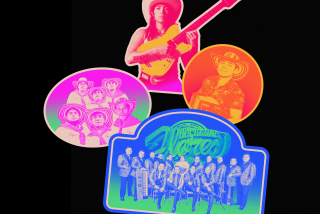Latin pops gets Hollywood Bowl crowd jumping
Three years ago at Gustavo Dudamel’s famous first concert as music director of the Los Angeles Philharmonic — a free celebration at the Hollywood Bowl that was piped around the world — the stellar young Venezuelan conductor joyfully disdained separatist geography. He told the impassioned crowd that he envisioned a single American continent where there is no north, no south, no central. We are one, he proclaimed, to roaring cheers. Had Dudamel wanted to be L.A.’s mayor and had there been an election the next day, he could now be pulling out his curls coping with a big city’s woes.
He’s not, at least yet, a politician, but Dudamel has doggedly kept beating the all-Americas drum. A highlight of his first season at Walt Disney Concert Hall was an “Americas and Americans” festival. Tuesday night, Dudamel inaugurated a second “Americas and Americans” festival, this time at the Hollywood Bowl. In his opening remarks to the crowd, he proclaimed our musics are also one. By that he meant classical and pop.
Actually, this weeklong Bowl festival is essentially south of the border. The only major U.S. work is on Thursday’s program, Copland’s patriotic 1945 Third Symphony, written while the composer was spending quite a bit of time in Mexico. All the soloists, no matter the genre, are Latin. Canada is nowhere in the picture.
The first half of Tuesday’s pops-style L.A. Phil program was devoted to Mexican, Argentine and Brazilian orchestral favorites, ending with the Carmen Miranda hit “Tico-Tico.”
After intermission Dominican star Juan Luis Guerra joined Dudamel and the L.A. Phil — actually the orchestra joined the singer as a kind of high-gloss window dressing for Guerra’s own hot band — and they got the audience dancing in the aisles.
It was an energizing show, impossible to resist. But it was in no way genre- or geography-busting. Rather, it was an if-this-is-Tuesday-it-must-be-Saturday show at the Bowl, namely a terrific Latin pops program taking up a symphonic spot.
Latin it surely, and interestingly, was. Dudamel addressed the crowd in Spanish and English. Guerra spoke mainly Spanish. His songs were not translated. When it comes to classical music, everything these days is explained and translated. But Guerra simply trusted the music, which hardly prevented the non-Spanish speaking contingent from joining the singer’s fans in waving hands, bouncing up from benches and seats and demanding encores.
An L.A. Phil concert, with an exuberant 10,429 in attendance, is not a place for crankiness. But the fact is Dudamel and the orchestra missed an excellent occasion to really bring two worlds together.
The short orchestral pieces in the first half proved, of course, a predictable delight. But José Pablo Moncayo’s infectious “Huapango” and Arturo Márquez seductive “Danzón No. 2” tend to be the two pieces always dragged out to represent Mexico. Rather than major tango by Astor Piazzolla (or maybe one of John Adams-Piazzolla arrangements), Dudamel played a square 3-minute version of “La Muerte del Angel.” Dudamel then led an impassioned account of the prelude to Villa-Lobos’ Bachianas Brasileiras No. 4, but he stopped there, avoiding the arrestingly engaging other three movements.
The orchestra played with pizazz. They, however, looked stiff in close-up on video, as if out of their element. This might have been an opportunity to show the Guerra crowd what the orchestra could do with a big piece by Villa-Lobos or Piazzolla or maybe a symphony by the great Mexican composer Carlos Chavez.
Guerra, of course, didn’t hesitate to show us what he can do, which is combine several Latin (such as the bachata and merengue), jazz and pop styles into an attractively tuneful, soulful, slightly nostalgic, slightly vulnerable, socially conscious, spiritual whole. For his set of nine songs, he had his impressive rhythm section on his left, his brass section on his left, fronted by two gracefully lithe backup singers. The stiffly superfluous L.A. Phil, behind clear acoustic shells, was in the back. He also had the help of many in the audience singing along.
Dudamel didn’t have a lot to do. But that gave him a chance to dance a little himself, seemingly having the time of his life sharing the stage with a pop idol of his youth. Mainly, though, Dudamel seemed happiest sharing another of his musical sides with his L.A. Phil followers. The audience couldn’t have appeared more grateful, but maybe that was all the more reason to have added more symphonic substance.
More to Read
The biggest entertainment stories
Get our big stories about Hollywood, film, television, music, arts, culture and more right in your inbox as soon as they publish.
You may occasionally receive promotional content from the Los Angeles Times.











